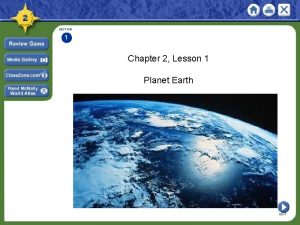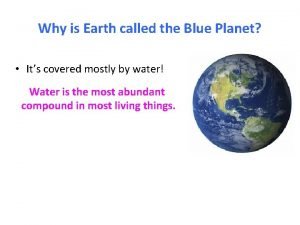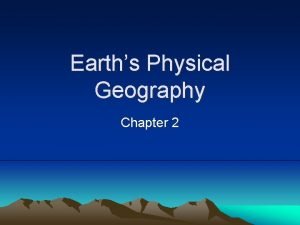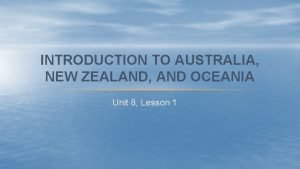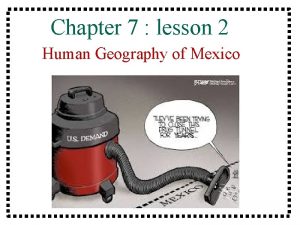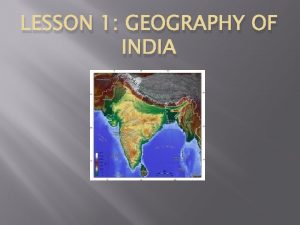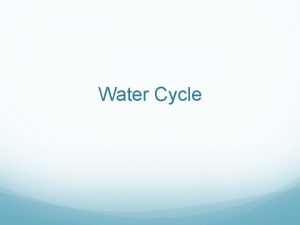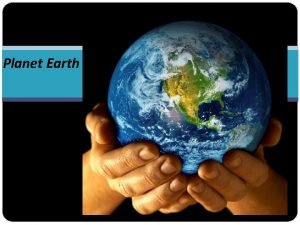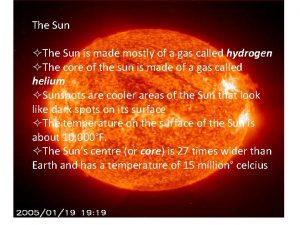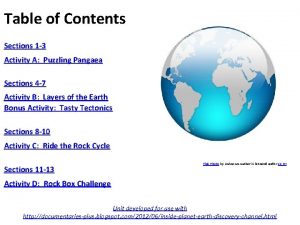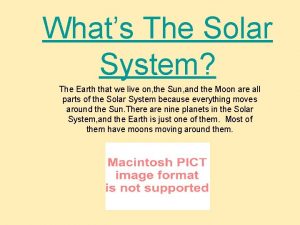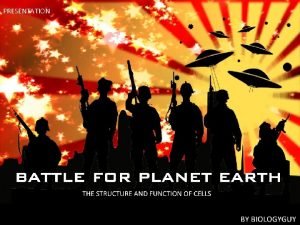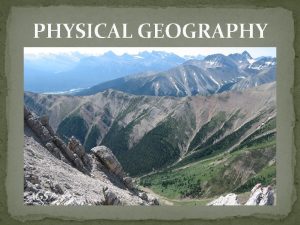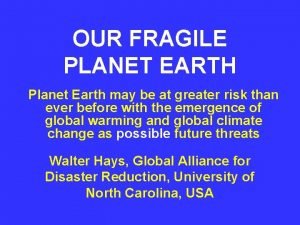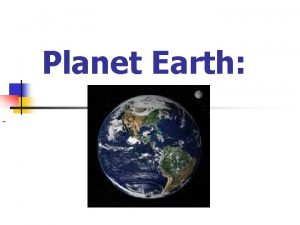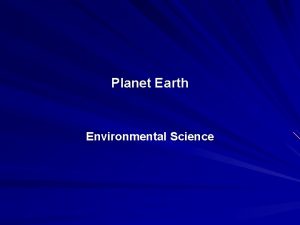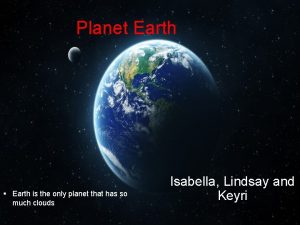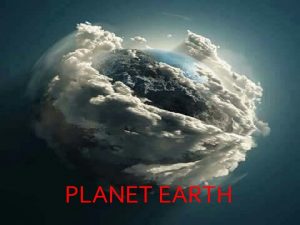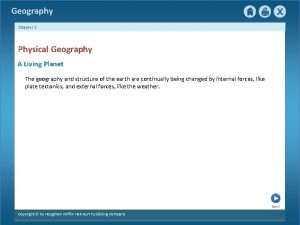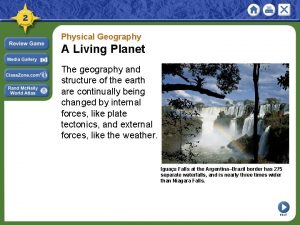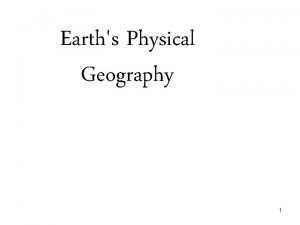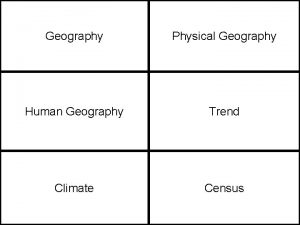Physical Geography Lesson 1 Planet Earth Earth is















- Slides: 15

Physical Geography Lesson 1: Planet Earth

• Earth is one planet among a group of planets and other bodies that revolve, or orbit, the sun and make up the solar system. • Earth rotates on its axis. One rotation takes 24 hours. As Earth rotates, some areas are in sunlight (day), and others are in darkness (night).

• Earth is made up of three layers: the core, the mantle, and the crust. There is a solid inner core and an outer core of melted, liquid metal. In the mantle layer, a thick layer of magma surrounds the core. The crust, Earth’s rocky outer shell, ranges in thickness from 2 miles (3. 2 km) under oceans to about 75 miles (121 km) under mountains. • Earth’s four physical systems are the hydrosphere (water), the lithosphere (crust), the atmosphere (gases that envelop Earth), and the biosphere (all living things).

• Because Earth’s axis is tilted as it orbits the sun, the sun’s direct rays reach different parts of the globe at different times of the year, which causes seasons. • On or about June 21, summer begins in the Northern Hemisphere and winter begins in the Southern Hemisphere. • On or about December 22, summer begins in the Southern Hemisphere and winter begins in the Northern Hemisphere.

Climate • Climate around the world is different depending on where you are and when you are there. • No two places on Earth are exactly alike, therefore no two places share the same climate. • However, there are similar climate types all round the world. • The Koppen climate classification system allows us to classify world climates into groups. It divides the world’s climates into four main types.

• Climate describes the average weather conditions in an area over a long period of time. • Weather refers to conditions in the atmosphere at any given time.

• Elevation, wind and ocean currents, weather, and landforms affect climate. • Earth is divided into climate zones based on temperature, precipitation, distance from the equator, and elevation.

• Many scientists say the world’s climates are changing. • Some of this change may be due to human activity. • Scientists have noticed global warming, an increase in the average temperature of Earth’s atmosphere.

The climate zones are: tropical, desert, humid temperate, cold temperate, polar, and high mountain. Foldable

Tropical Climate • Type A • Mostly located in a ring around the middle of the globe. • Lie between latitude 15°N and 15°S. • Known for being warm all year round. • Average temperatures do not fall below 64°F • Many are tropical rain forests. • Many receive over 100 inches of rain a year. • Have two seasons wet and dry. • They are frost free which means they have a year round growing season. • The rain forests of Central and South America are good examples.

Humid Temperate • Type C: • One of the most common climates around the world. • Located in the lower parts of the northern continents. • Between 25°-75°N and 25°-75°S latitude. • Has four seasons, but winter is not that cold. • Average temperature of 56°F • Gets about 32 inches of rain per year • Tends to be influenced by ocean currents. • Spain, Alabama, South Carolina are all examples of this climate.

Polar • Type E • Found mostly above or below latitude 60°N or S. • The North Pole and Antarctica cover most of the polar region. • They are cold all year long. • Temperatures do not exceed 50°F. • Get NO precipitation only snow. • Covers 20% of the planet • Receives 6 months of daylight and 6 months of night. • The extreme temperatures result in tundra, glaciers, or permafrost (always frozen ground) • Cool summers, Cold Winters • Alaska and parts of Canada are examples of this climate.

Desert • Type B • Dry and Arid • Found mostly between latitude 50°N and 50°S • Usually hot and sunny • Water evaporates quickly in this climate and rarely falls as precipitation. • Not enough water to maintain most vegetation. • Tends to be filled with scrub bush • Highs can reach 122°F or higher in the deep desert during the day • Can reach below freezing at night • We are an example of this climate.

Cold Temperate • Type D • Also called continental climate • Must have 30 days of snow on the ground a year. • Hot summers and cold winters • Has four seasons • Occurs more in the Northern Hemisphere • Precipitation tends to occur in summer between 24 and 47 inches per year • Tends to be forested. • Between 25°-75°N and 25°-75°S • Continental winters are colder than temperate winters.

High Mountain • Type B • Very little precipitation. • This is also called the Cold Desert • Scotland mountain tops are Climate. examples of this climate • Very little vegetation • Too high for trees to grow • Also referred to as Highland Climate because it occurs above a certain elevation.
 Lesson 1 planet earth
Lesson 1 planet earth Why is earth called the blue planet
Why is earth called the blue planet Earth's physical geography chapter 2
Earth's physical geography chapter 2 Lesson 1: an introduction to oceania
Lesson 1: an introduction to oceania Lesson 1 physical geography of southeast asia
Lesson 1 physical geography of southeast asia Lesson quiz 13-1 eastern europe
Lesson quiz 13-1 eastern europe Lesson 1 physical geography of south america
Lesson 1 physical geography of south america What influenced mexico's political and social structures
What influenced mexico's political and social structures States west of the mississippi river
States west of the mississippi river Continent of nepal
Continent of nepal Run off water cycle
Run off water cycle We live on planet earth
We live on planet earth The sun is made mostly of .
The sun is made mostly of . Tasty tectonics answer key
Tasty tectonics answer key Whats the farthest planet from earth
Whats the farthest planet from earth What is this
What is this
